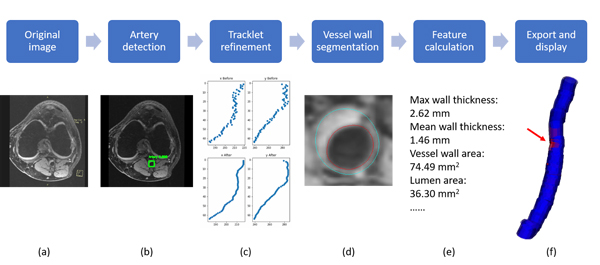Fully automated and Robust Analysis Technique for Popliteal Artery Vessel Wall Evaluation (FRAPPE) using Neural Network Models from Standardized Knee MRI
Li Chen, Gador Canton, Wenjin Liu, Daniel S. Hippe, Niranjan Balu, Hiroko Watase, Thomas S. Hatsukami, John C. Waterton, Jenq-Neng Hwang, Chun Yuan
Abstract:
Purpose:
To develop a fully automated vessel wall (VW) analysis workflow (FRAPPE) on the popliteal artery in standardized knee MR images.
Methods:
Popliteal artery locations were detected from each MR slice by a deep neural network model and connected into a 3D artery centerline. Vessel wall regions around the centerline were then segmented using another neural network model for segmentation in polar coordinate system. Contours from vessel wall segmentations were used for vascular feature calculation, such as mean wall thickness and wall area. A transfer learning and active learning framework was applied in training the localization and segmentation neural network models to maintain accuracy while reducing manual annotations. This new popliteal artery analysis technique (FRAPPE) was validated against manual segmentation qualitatively and quantitatively in a series of 225 cases from the Osteoarthritis Initiative dataset.
Results:
FRAPPE demonstrated high accuracy and robustness in locating popliteal arteries, segmenting artery walls and quantifying arterial features. Qualitative evaluations showed 1.2% of slices had noticeable major errors, including segmenting wrong target and irregular vessel wall contours. The mean Dice similarity coefficient with manual segmentation was 0.79, which is comparable to inter-rater variations. Repeatability evaluations show most of the vascular features have good to excellent repeatability from repeated scans of same subjects, with intraclass coefficient ranging from 0.80 to 0.98.
Conclusion:
This technique can be used in large population-based studies, such as OAI, to efficiently assess the burden of atherosclerosis from routine MR knee scans.
Key words
Atherosclerosis; Vessel wall imaging; Vessel wall segmentation; Popliteal artery; Machine learning
Accepted by Magnetic Resonance in Medicine
https://onlinelibrary.wiley.com/doi/abs/10.1002/mrm.28237
Media report:
https://newsroom.heart.org/news/seattle-scientist-wins-competition-for-artificial-intelligence-research
https://newsroom.uw.edu/postscript/knee-mris-can-depict-cardiovascular-risk-ai-affirms-it
